by Reid Dickie and Linda Tooley
The tradition continues!
For the fourth year running, Reid and Linda celebrate the Twelve Days of Christmas with an online heritage event. In past years, Manitoba heritage churches and houses were featured. This time we have chosen some of Winnipeg’s finest old schools.
The text and pictures (most taken by Reid) are excerpted from his unpublished book, This Old School: 41 Historic Winnipeg Schools. This local history book profiles Winnipeg’s grand old schools and Winnipeg’s heritage of extraordinary advances in school design and curriculum. Linda has once again selected snippets from some favourite seasonal songs to end each greeting.
We are revealing one heritage school each day, concluding on Boxing Day.
Link to day:
Today 1 | 2 | 3 | 4 | 5 | 6 | 7 | 8 | 9 | 10 | 11 | 12
Day 1
Luxton School
111 Polson Avenue, Winnipeg
School location in Google Maps
School web site
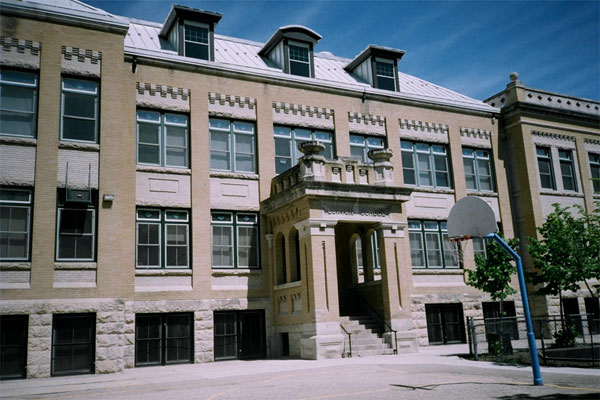
Because it sits on high ground, Luxton School was headquarters for the Police, Navy and Scotia Street Flood Sufferers Association during the 1950 flood. Located east of Main Street, the school sits at the top of a steep rise that falls away to the Red River. Floodwaters rose so high the Navy docked their boats near the school. The building we see today is actually two distinct places, both designed by School Architect J. B. Mitchell but built eight years apart. This concrete, limestone and pale brick building has the original 1908 section on the east and the 1916 addition on the west. The detailing and execution of the later part are much better quality. William Fisher Luxton, besides being Winnipeg’s first school teacher, was a founder of Winnipeg General Hospital, a charter member of the Winnipeg Board of Trade, a member of the provincial Board of Education and active in provincial and federal politics. Another of his lasting contributions was the Manitoba Free Press, which he started with John Kenny on November 9, 1872. It evolved into the Winnipeg Free Press in 1931. Luxton died the year construction of the school began. His portrait still hangs in the school. Illustrious alumni of Luxton School tend toward the arts and show business including novelist Adele Wiseman, game show host Monty Hall, singer Burton Cummings and City of Winnipeg Film and Special Events Manager Kenny Boyce.
“From angels bending near to earth.” |
Back to top of page
Day 2
École Provencher
300 Avenue de la Cathedrale, Winnipeg
School location in Google Maps
School web site
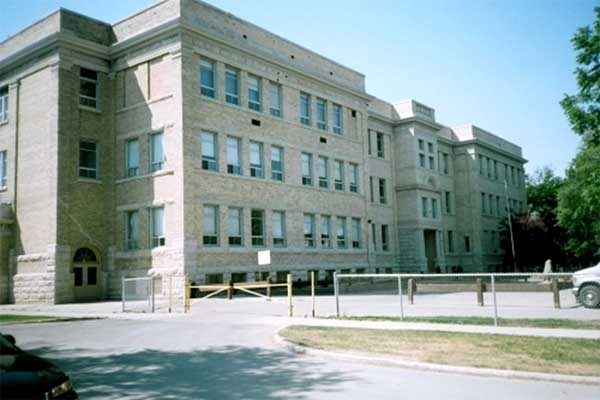
École Provencher’s history extends back to the earliest Catholic school in the Red River settlement. About 1818, the first missionary in the region, Father (later Bishop) Provencher, used his chapel as a school where he taught boys the four Rs: reading, writing, arithmetic and religion. In 1844, the Grey Nuns assumed responsibility for the school. In 1906, the School Board constructed a school at the site where École Provencher stands today. It was a modest three-storey brick and limestone building, featuring an entry tower surmounted with an elegant ogee roof. The central 12-room portion of the current building is the original 1906 section. Built in 1912, the west wing doubled the size of the school to 25 rooms. The basement of the school had shops for teaching industrial arts. Dating back to 1911, this could be the earliest shop class taught in Winnipeg. The Provencher School Cadet Corps is one of the oldest cadet corps in Manitoba. The school basement doubled as a firing range. Some of the heating ducts still have dents from stray bullets. The Corps’ old drum, along with the school’s trophies and memorabilia, is displayed proudly in a striking stairwell vitrine. Acclaimed author Gabrielle Roy, a Grade 1 teacher at École Provencher, taught there from 1930 to 1936. Artist and sculptor Tony Tascona remembered her as his first teacher. École Provencher celebrated its centennial in 2006. As part of the celebrations, the entire façade of the school was sandblasted back to its original bright limestone face. You can see the difference between the cleaned facade and untouched stone on the left side of the picture.
“It’s the best time of the year.” |
Back to top of page
Day 3
Isbister School / Winnipeg Adult Education Centre
310 Vaughan Street, Winnipeg
School location in Google Maps
School web site
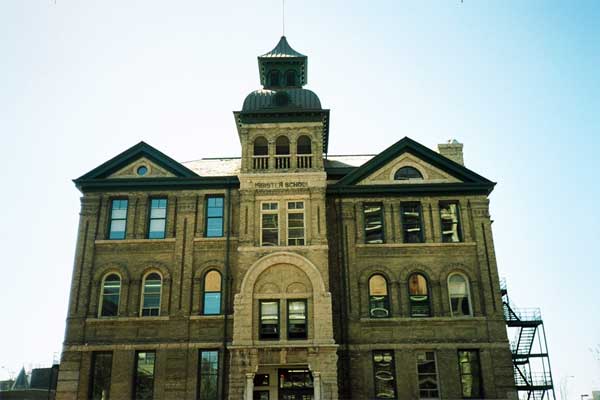
The oldest public school in Winnipeg and the last old downtown school sits rather anonymously on Vaughan Street, just north of The Bay. The land Isbister School stands on once belonged to the Hudson’s Bay Land Reserve. The School Board purchased a block of lots at $100 each from the Hudson’s Bay Company and in the summer of 1898, the contract for this ten-room, three-storey building was let. Architect Samuel Hooper supplied the plans. On Isbister School, Hooper employed Queen Anne style architecture, an eclectic style used mainly for residential buildings in Winnipeg. This makes any public building using the style particularly special. After decades of service, Isbister School suffered the fate of other downtown schools suddenly in the middle of business districts rather than residential neighbourhoods. Dwindling enrolments caused the school’s closure in 1964 and it seemed likely the old place would be demolished. It received a reprieve, becoming the Adult Education Centre in September 1967. It even survived the 2004 onset of an incongruent steel, concrete and glass addition on the north and west sides. Luckily, the façade retains its 1898 face, glorious even with pollution-darkened brick. (My picture makes it look mossier than it is. It has all its windows now, too.) The school bears the name of Alexander Kennedy Isbister, the son of Orkneyman Thomas Isbister and Cree Mary Kennedy, who was born in 1822. Isbister studied at universities in Scotland and England becoming a teacher and writer, completing 21 textbooks. Among the illustrious alumni of Isbister School, you’ll discover Skuli Johnson, an early Rhodes Scholar, local printer Gordon Stovel and singer/comedian Pat Riordan.
“Make the Yule-tide gay.” |
Back to top of page
Day 4
Laura Secord School
960 Wolseley Avenue, Winnipeg
School location in Google Maps
School web site
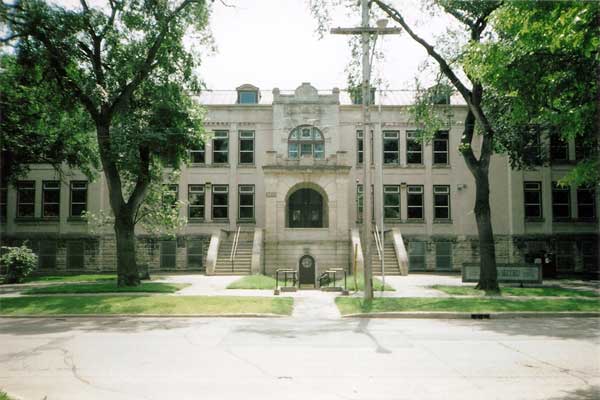
In December 1913, when Mrs. Isaac Cockburn, Laura Second’s granddaughter, formally opened the ten completed rooms, the school stood among empty market garden fields on the fertile banks of the Assiniboine River. The area was largely vacant lots but there was an amusement park called Happyland situated between Garfield and Sherburn. When completed, Laura Secord School was the most modern building of its kind in the city. Twenty-six classrooms, two manual training rooms, a huge auditorium that seats 800, shops, showers and a third floor caretaker suite made it one of the largest schools built during the era. It covered over 25,000 square feet per floor and was 72 feet tall. The similar shading of materials on Laura Secord demonstrates how they age and discolour differently. All the limestone has a dirty appearance because it tends to accumulate pollutants faster than the brick. This is very evident on the foundation and windows sills and is common on many older buildings with limestone elements. While the stone darkens, the brick develops a patina, adding to its lightness. Laura Secord School’s most stunning feature is the baroque entranceway. Among the school’s illustrious alumni is entertainer Fred Penner who attended in the early 1950s.
“Oh! Hush the noise, ye men of strife,
and hear the angels sing.” |
Back to top of page
Day 5
La Verendrye School
290 Lilac Street, Winnipeg
School location in Google Maps
School web site
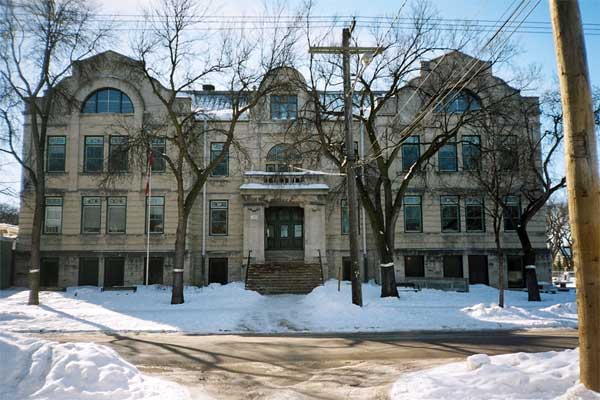
La Verendrye School, one of Winnipeg’s grandest old schools from the boomtown era, is set perfectly between Jessie Avenue and Warsaw Avenue on Lilac Street. Though residential and business areas quickly grew up around it, when it opened in 1909 La Verendrye School was on the outskirts of the developing city. Reporting on the school’s cornerstone laying on July 8, 1909 by Ward 1 Trustee F. C. Hubbard, the Manitoba Free Press wrote, “Yesterday visitors journeyed to the ground or within 100 yards of it by electric car and found there was still something of Winnipeg beyond them, though the streets lose some of their garb of traffic and dwellings are hidden in areas of native bush.” Based on a design by School Division Architect and Commissioner of School Buildings J. B. Mitchell and constructed of local brick and limestone, La Verendrye School is a commingling of Queen Anne, Romanesque Revival and Classical Revival architectural styles. Among La Verendrye School’s near-century of alumni, you will find Terry Fox’s father, Rolly and artist Nathan Carlson. The centennial of La Verendrye School, now a French immersion elementary school, occurs in 2009. To prepare, the school is involved in a major history project. They are setting up a historical classroom, as it would have appeared in the early 1900s, complete with teaching aids of the era. This will enable children to live their history.
“Up on the housetop, click, click, click.” |
Back to top of page
Day 6
Linwood School
266 Linwood Street, Winnipeg
School location in Google Maps
School web site
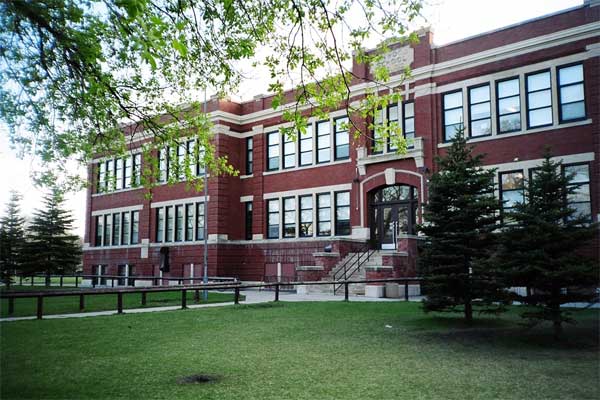
Pop quiz! What Winnipeg school’s alumni includes the city’s first female mayor Susan Thompson, bandleader Jimmy King, Liberal Cabinet Minister Mitchell Sharp, speed skater Gordon Audley, provincial Minister of Finance Greg Selinger, and National Defense Headquarters Chief of Air Staff Ken Pennie? Hint: it’s in St James. It’s Linwood School! Scottish-born Winnipeg architect Alexander Melville designed the school, built of wine-red brick and limestone. Melville, and his enigmatic brother William, a civil engineer, were responsible for at least fourteen Winnipeg’s fire halls, many of them still standing. (Under the heading of Winnipeg Degrees of Separation, Susan Thompson, besides attending the Melville-designed Linwood School, was later a resident in a Melville-designed fire hall on Dorchester Avenue that had been renovated into condominiums.) Curiously, at the back of completely symmetrical Linwood School is a pair of entrances. Grandly carved in limestone over one door is “BOYS” and over the other “GIRLS.” Apparently, the reason was logistical: boys and girls lockers were most easily accessible through the separate doors. From its opening in 1914, the school held elementary classes on the main floor and high school classes above. When St. James Collegiate opened in the early 1950s, the higher grades moved there.
“Jingle all the way.” |
Back to top of page
Day 7
School’s Out
Three schools that no longer exist, their names gone from the current school roster, their bricks and mortar razed. What remains are the memories, wisdom and accomplishments of former students.
Alexandra School
Former school location in 1906 Winnipeg map
(Library and Archives Canada)
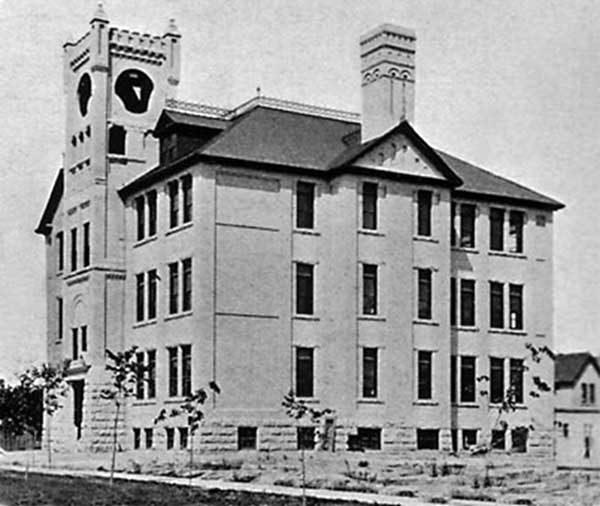
Named for King Edward VII’s consort, Alexandra School was built by the notorious Kelly Brothers in 1902-03 at Edmonton Street & St. Mary Avenue where the Winnipeg Convention Centre now stands. A true showplace of the time, it was designed by Architect and Commissioner of School Buildings J. B. Mitchell. Alexandra School became a template for many of his best school designs. Originally a two-storey building, the third floor was added when enrolment justified it. Downtown Winnipeg changed from a business/residential mix to almost all businesses. The school was demolished in 1969.
St Mary’s School
Former school location in 1906 Winnipeg map
(Library and Archives Canada)

Administered by Catholic educators, St. Mary’s School was located downtown where the Delta Hotel stands today at St. Mary Avenue and Hargrave Street, one block east of Alexandra School. Samuel Hooper supplied the design. The school was completed in 1904. St Mary’s School’s illustrious alumni include William Richard Bawlf, grain merchant and president of the Winnipeg Grain Exchange; and Francis Laurence ‘Bud’ Jobin, politician and Manitoba’s lieutenant governor in the late 1970s. The school closed in 1968. A fire in 1969 sealed its fate and it was demolished in 1971.
Winnipeg Collegiate Institute
Former school location in 1906 Winnipeg map
(Library and Archives Canada)
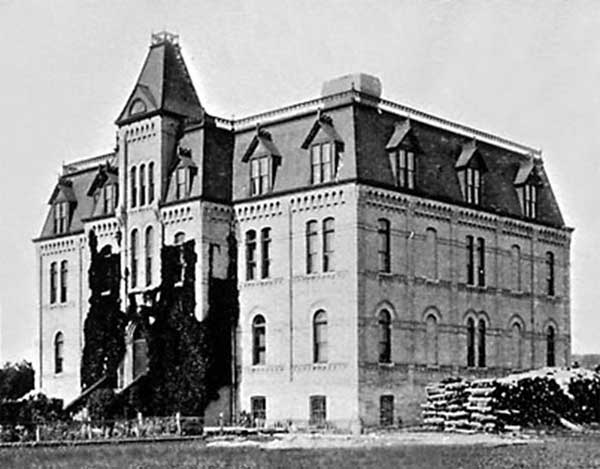
In 1892, the school board chose a site at William and Kate, where Hugh John Macdonald School stands today (567 Bannatyne Avenue), to build the city’s first high school, Winnipeg Collegiate Institute. Initial enrolment was 360 students. Among its early alumni are writer, teacher and suffragette Nellie McClung, physician and educator Joseph Lamont, doctor and Wawanesa Insurance executive Charles Vanstone, physician, politician and psychic researcher T. G. Hamilton, and provincial Conservative Party leader and judge Fawcett Taylor. Though the school’s physical systems were current when it was built, it soon became too expensive to repair and was slated for demolition in 1930 to make way for Hugh John Macdonald School.
“Pa Rum Pum Pum Pum.” |
Back to top of page
Day 8
Winnipeg Technical Vocational High School (Tec Voc)
1555 Wall Street, Winnipeg
School location in Google Maps
School web site
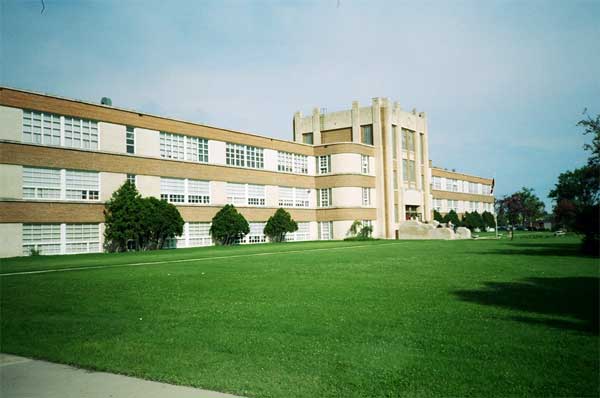
Since it opened in 1951, Technical Vocational High School’s curriculum, which combines vocational training with related academics, has reflected the changing needs of a modern society. Its architectural design and materials meant Tec Voc was the height of modernity. Architect W. A. Martin combined two significant 20th century architectural styles: Art Deco and Art Moderne. Of all his school designs, Tec Voc is Martin’s crowning achievement. Look at all those horizontal lines! That elegant Art Deco entrance tower! Carved in limestone over a Tec Voc side entrance are these words: “Knowledge without practice makes but half an artist.” From the outset, Tec Voc featured an innovative music program directed by Fred Merrett. Gilbert and Sullivan operettas were presented annually and seldom did a parade pass by that did not feature the Tec Voc Marching Band complete with majorettes. A tradition of the Home Economics Department was the annual wheelchair banquet where Tec Voc students prepared and served a gourmet meal to disabled Winnipeggers. Tec Voc has produced dozens of teachers, engineers, professors and politicians. Notable alumni include former city councilors Norman Stapon and Al Ducharme, NHLer Cece Hoekstra, ventriloquist Bob Swartz, TV’s Uncle Bob on Archie and His Friends, singer/comedian Pat Riordan, former Winnipeg Police Chief Jack Ewatski, and Linda.
“Ho. Ho. Ho. Who wouldn’t go?” |
Back to top of page
Day 9
Somerset School
775 Sherbrook Street, Winnipeg
Former school location in 1906 Winnipeg map
(Library and Archives Canada)
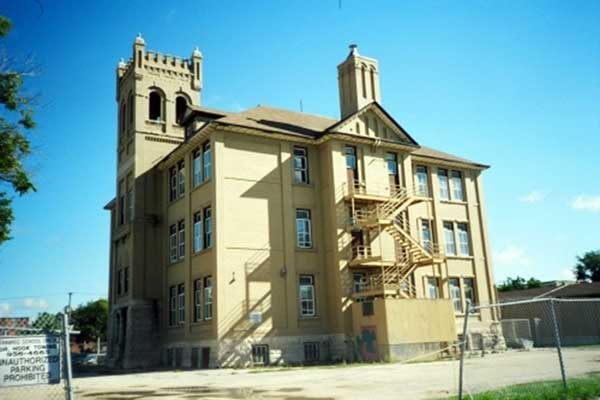
Sadly, Somerset School has become the latest school designed by Winnipeg’s first Schools Architect and Commissioner of School Buildings J. B. Mitchell to succumb to the wrecking ball. In April 2005, at age 104, the school was demolished to make way for a drugstore. This earns Mitchell the dubious distinction of being among the “most demolished” architects in Winnipeg’s history. Mitchell’s design for Somerset School was on the vertical plan – three storeys of buff brick with an impressive entry tower and prominent matching side chimneys above large pediment gables. The school was an expensive building. Its ten rooms and assembly hall cost $40,000 to build. The amount was deemed acceptable because of the school’s size and permanence. It boasted a drinking “fount” in every classroom and electric lights in place of oil lamps. The school was built in 1901 to serve the growing population around Nena (now Sherbrook) Street, mainly of Icelandic and German origins. The west-end between Ellice and Logan had a very large Icelandic population. Early teachers used readers that were German-English, Ruthenian-English and Icelandic-English. Facing Sherbrook Street, you will find a ghostly reminder of once-elegant Somerset School: the limestone block from the original tower with the school name carved into it is displayed at street level between the sidewalk and the drugstore parking lot.
“Mix and a-mingle in the jingling feet.” |
Back to top of page
Day 10
Assiniboine School
175 Winston Road, Winnipeg
School location in Google Maps
School web site
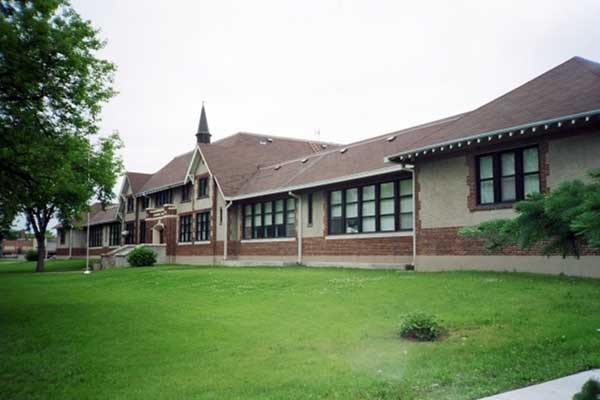
A glimpse of Assiniboine School from Portage Avenue confounds the eye. Is it an alpine chalet, a prairie railway station, or maybe a gothic church? A hybrid of all three, the result is the most picturesque roofline of all Winnipeg schools. The study in horizontals embodied in the building compliments the numerous levels and angles of the roof. Its jaunty flow accentuates the open space of the surrounding schoolyard. Built in 1922, Assiniboine School provides a compelling silhouette against the big sky beyond. If you needed a term for its style, try Picturesque Gothic. The metal steeple above and the steep gables beside the main entry create a warm uplifting feeling. The use of varied materials contributes to the building’s elegance. Brick, wood and stucco infilling combine with ubiquitous limestone trim to offer visual interest and a lively optimistic feeling around the exterior. Contrasting red brick accentuates corner and window trim details. Large brackets and exposed rafter tails add horizontal emphasis. The entry hall features a large striking mural depicting an aboriginal campsite, one of two stylized murals installed in 1930. Both murals were painted in the 1920s by students from the School of Art at the University of Manitoba. One of the murals disappeared in the 1960s and its whereabouts remains a mystery. It is believed the remaining painting is by Manitoba artist Lulu Bingham.
“Snowing and blowing up bushels of fun.” |
Back to top of page
Day 11
Daniel McIntyre Collegiate Institute
720 Alverstone Street, Winnipeg
School location in Google Maps
School web site
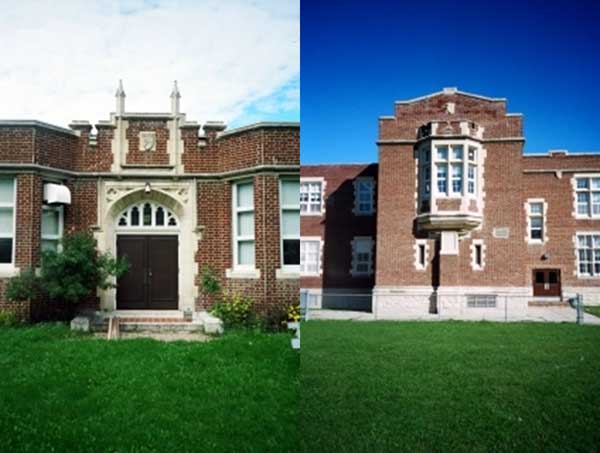
Daniel McIntyre spent 43 years as Winnipeg School Division Superintendent bringing wisdom, imagination and innovation to the Winnipeg school system. The school bearing his name is an appropriately handsome tribute with an evident sense of history. In the early 1920s, the School Board asked architect Colonel John N. Semmens to design the school. Semmens viewed Daniel McIntyre Collegiate as the most important school in western Canada. It is a magnificent creation! Set on a limestone foundation this massive, two-storey school is a variation on Gothic Revival style known as Collegiate Gothic when used for educational institutions. It is loaded with Gothic details like the stunning entrance from the quad (above left) which features a smooth limestone peaked arch with Gothic tracery and quatrefoils over the door. Above the entry, a small section of the roofline is castellated and supports a pair of pointed pinnacles. More Gothic details abound on the side wings: oriel windows and a battlement (above right) supported by a large pilaster giving the impression of an elegant wine goblet. Daniel Mac alumni are diverse. Former students include 1950s Blue Bomber Cecil Luining (four Grey Cups), former Winnipeg mayor Bill Norrie, former CPR president and Senator Ian Sinclair, former Lieutenant Governor George Johnson, former premier Howard Pawley, bandleader Marsh Phimister, Guess Who guitarist Kurt Winter, painter/sculptor Bruce Head, singer/songwriter Stewart Fay, Blue Bomber Markus Howell and NHLers Ernie Dickens and Paul Platz. Group of Seven artist Frederick Varley painted a large portrait of Dr. Daniel McIntyre, which was presented to the school in 1940. Today the painting hangs imposingly in the school library.
“A beautiful site. We’re happy tonight.” |
Back to top of page
Day 12
Earl Grey School
340 Cockburn Street North, Winnipeg
School location in Google Maps
School web site
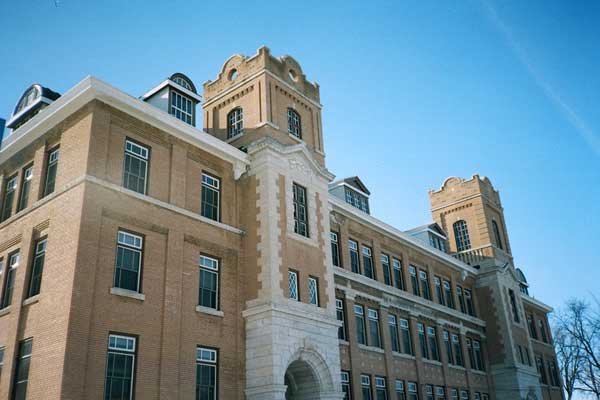
My favourite school and the one that sparked my interest in architecture, Earl Grey School is one of School Architect J. B. Mitchell’s most spectacular designs - huge, beautiful and expensive. Settled handsomely at the corner of Cockburn Street and Fleet Avenue and towering above its Fort Rouge neighbourhood, three-storey Earl Grey is truly one of Winnipeg’s grand old schools. Costing nearly $160,000 to build, construction began in 1914 during the city’s boom time when population growth was exploding. The first students attended in September 1915. Its impressive façade with the pair of asymmetrical entrance towers is loaded with elegant details. If you have ever wondered what a million bricks look like in one place, check out Earl Grey School. The school was named after popular Governor-General of Canada Lord Earl Grey who served from 1904 to 1911. An avid sports fan, the Earl initiated the Grey Cup in 1909. In 1919, Earl Grey School became the site of a major educational innovation - it was the first Junior High School in western Canada. Over its ninety-three-year history, the school has produced many illustrious alumni. Former Winnipeg Mayor Robert Steen, media philosopher Marshall McLuhan and musician Neil Young all attended Earl Grey. At one time, both signatures on Canadian paper money were Earl Grey graduates: James E. Coyne was a former Governor of The Bank of Canada, and Robert E. Beattie, a former Deputy Governor.
“Although it’s been said many times, many ways,
Merry Christmas to you.” |
Back to top of page
Happy Holidays!
Note:
To find other great maps of Winnipeg from 1906 (and other years), visit the web site of Library and Archives Canada (www.collectionscanada.ca). Under Archives Search, type Fire Insurance Plans of Canada, Manitoba. Click on Insurance Plan of the City of Winnipeg, Manitoba, Canada, Volume 1, August 1906.
Page revised: 22 February 2016
|
|